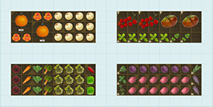Basics
- Ease of Growing
- Moderate
- Grown as
- Annual
- Days to Maturity
- 90-95 (Spring/Summer)
- Growing Habit
- Vine
- Hardiness
- Tender
Beans are temperature sensitive and shouldn't be planted until the soil has reached at least 65˚ F.
- Crops
- Spring Transplant, Spring, Summer
- Growing Season
- Long
- Cultivar Type
- -
- Growing Conditions
- Warm, Hot
To grow dry beans you plant them all at once, as soon as the soil is warm enough. They need a longer period of warm weather to produce dry beans. They are not at all hardy and any frost will kill them. Beans like a warm sunny spot.
- Outdoor Growing Temp
- 60°F - 80°F
- Min Outdoor Soil Temp
- 60°F
Don’t plant Pole Beans out until all frost danger is past and the soil is warm (at least 60˚ F and ideally 80˚ F). If beans are planted in cold soil, they may rot. You can warm the soil beforehand with cloches or plastic mulch, or start them indoors if you must have an early crop.
- Start Indoors
- Yes
- Start Outdoors
- Yes
- Light
- Water
- Moderate
Beans should have evenly moist soil at all times. Water lightly at planting, medium at flowering, and heavily throughout harvest time. Avoid overhead watering which can promote disease.
- Feeder
- Moderate
Low nitrogen. Moderate potassium. Moderate phosphorous.
Beans don't need a lot of nitrogen in the soil because they fix their own. In fact, if there is a lot in the soil they won't go to the trouble of fixing it. They do need plenty of potassium and phosphorus though.
They are sometimes planted after a crop that was heavily amended, or after a winter cover crop.
- Suitability
- Small Gardens?
- Yes
- Containers?
- No
- Attracts beneficial insects?
- No
- Color
- Black
- Fruit Size
- - "
- Plant Height
- 84.0 - 96.0"
- Plant Diameter
- 12.0 - 18.0"
- Good Companions
- Sage, Radish, Marjoram, Cauliflower, Strawberry, Marigold, Summer Savory, Celery, Squash, Summer, Dill, Eggplant, Chard, Nasturtium, Squash, Winter, Potato, Pumpkin, Corn, Cabbage, Carrot, Cucumber, Lettuce, Parsnip, Parsley, Rosemary, Tarragon, Peas
- Bad Companions
- Beet & Beetroot, Rutabaga, Turnip, Kohlrabi, Finocchio, Garlic, Chives, Fennel, Leek, Onion, Shallot
- Hardiness Zone
- 3-11
- Disease Resistance
- -
- Taste Profile
- Rotation Group
- Soil Builders and Cleaners: Legumes + Corn + Potatoes

